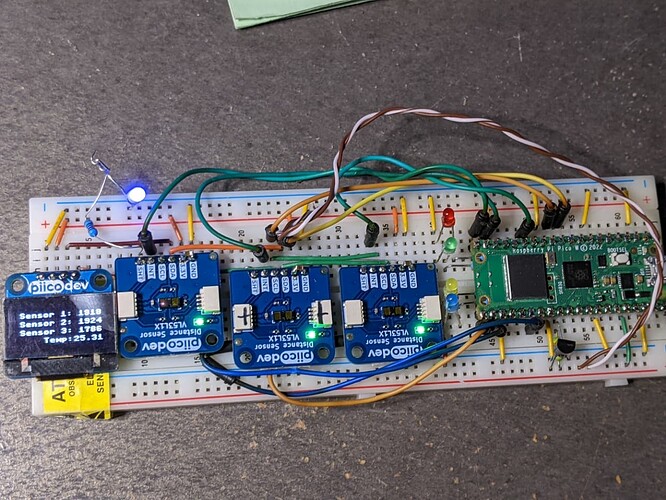Great news, everybody. I have a working program. Many thanks to Michael, who was pretty much on the money.
A couple of traps along the way. Firstly, the compiler didn’t like the print statement. Had to replace it with:
print(str(dist_1) + " mm " + str(dist_2) + " mm " + str(dist_3) + " mm ")
All the rest of the traps were my own sweet work, to one extent or the other, In the interests of disclosure, they were:
-
Voltage drop across the breadboard - there was 0.4V difference at the worst. It didn’t affect the Oled, but the XL53L1x modules suffered. The furthest one would not initialise
-
The enable pins were in the wrong order. Oops. I had triple checked those, and still got it wrong,
-
I would occasionally get lockups on the centre sensor. The number it locked on would vary, but one it had done it, they only recourse was a power down.
-
The readings would vary by over a metre, sometimes adjacent readings,
I tried it again when I got home, and the last two problems had disappeared. At work, they were sitting on my bench facing up, same as at home. Difference is, at home I don’t have LED downlights. The ones at work are controlled by dimmers - they glow up when you walk in the room. I suspect these are the culprits. When I covered them with a book around 600mm away, they stabilised. Thinking back, they were in shadow. Spent two hours on this, and got nowhere.
Thanks for all your help, folks. Appreciated.
For those that lke B-grade horror stories, the code:
from PiicoDev_Unified import sleep_ms
from PiicoDev_SSD1306 import *
from PiicoDev_VL53L1X import PiicoDev_VL53L1X
from time import sleep
from machine import Pin, Timer, PWM, ADC, I2C
import time, ds18x20, onewire
#Led definitions
led_green = Pin(13, Pin.OUT, value=0)
led_red = Pin(12, Pin.OUT, value=0)
led_blue = Pin(18, Pin.OUT, value=0)
led_yellow = Pin(19, Pin.OUT, value=0)
#pwm the white led
led_white = Pin(1, Pin.OUT, value=0)
pwm = PWM(led_white)
pwm.freq(800)
#VL53L1x definitions
GPIO_1 = Pin(15, Pin.IN) # reading acknowleged from VL53L0x
GPIO_2 = Pin(14, Pin.IN)
GPIO_3 = Pin(11, Pin.IN)
XSHUT_1 = Pin(20, Pin.OUT, value=0) # enable r/w of VL53L0x. 0 = disable
XSHUT_2 = Pin(17, Pin.OUT, value=0)
XSHUT_3 = Pin(16, Pin.OUT, value=0)
ds_loopcount = (0)
ds_pending = (0)
ds_initiated = (0)
#Oled
display = create_PiicoDev_SSD1306() # note address of LCD is 0x3C
# Text and numbers
for counter in range(0,101): # verified demo program for the lcd
display.fill(0)
display.text("Goodbye,",27,15, 1)
display.text("Cruel World",15,30, 1)
display.text(str(counter),50,45, 1)
display.show()
sleep_ms(100)
#Timers -RP2
tim1 = Timer()
#tim2 = Timer()
en_tim1 = True
#en_tim2 = True
tim1.init(period=800, mode=Timer.PERIODIC, callback=lambda t:led_green.toggle()) # toggle a LED on every cycle of the timer
#tim2.init(period=87, mode=Timer.PERIODIC, callback=lambda t:led_red.toggle())
Tim750mS = Timer()
#def set_pending(Tim750mS):
# ds_pending = (5)
# led_yellow.toggle()
# Tim750mS.deinit()
ow = onewire.OneWire(Pin(22)) # create a OneWire bus on GPIO22
ow.scan() # return a list of devices on the bus
ow.reset() # reset the bus
ow.readbyte() # read a byte
ow.writebyte(0x22) # write a byte on the bus
ds = ds18x20.DS18X20(ow) # set up a DS18x20
roms = ds.scan()
print('Found DS18B20')
ds.convert_temp()
time.sleep_ms(750)
for rom in roms:
print("Degrees C --> ", ds.read_temp(rom)) # output the temp reading
# initialise and change the addresses of two sensors
XSHUT_3.value(1)
Sensor_3 = PiicoDev_VL53L1X() # initalise sensor
Sensor_3.change_addr(0x2D) # change the address to 0x2D
XSHUT_2.value(1)
Sensor_2 = PiicoDev_VL53L1X() # initalise sensor 2
Sensor_2.change_addr(0x2B) # change the address to 0x2B
XSHUT_1.value(1)
Sensor_1 = PiicoDev_VL53L1X() # initalise sensor 1
while True:
# do 1-wire stuff for temp
if ds_initiated == 0: # test if we are reading or writing
ds.convert_temp() # do the conversion
# Tim750mS.init(mode=Timer.PERIODIC, period=1000, callback=set_pending)
ds_initiated = 1 # so it only runs once per conversion
# print("750mS timer set")
if ds_pending == 1: # it is a 750mS conversion time. Don't wait, get it on the next pass
# Tim750mS.deinit()
for rom in roms: # read the conversion
# process the temp reading
print("Degrees C --> ", ds.read_temp(rom))
# txt1 = f'{ds.read_temp(rom):.2f}' # convert the int to a string
ds_pending = 0 # toggle t0 repeat the process from the top
ds_initiated = 0
# It's showtime!
dist_1 = Sensor_1.read()
sleep(0.05)
dist_2 = Sensor_2.read()
sleep(0.05)
dist_3 = Sensor_3.read()
print(str(dist_1) + " mm " + str(dist_2) + " mm " + str(dist_3) + " mm ") # convert the number to a string and print
# print(f"{dist_1:4.0f}A, {dist_2:4.0f}B, {dist_3:4.0f}C) # print all distances on same line
# sleep(0.1)
# update the LCD
display.fill(0)
display.text("Sensor 1: "+ str(dist_1),10,12, 1)
display.text("Sensor 2: "+ str(dist_2),10,24, 1)
display.text("Sensor 3: "+ str(dist_3),10,36, 1)
display.text("Temp:",42,48, 1)
txt1 = f'{ds.read_temp(rom):.2f}'
display.text(txt1, 83,48,1)
display.show()
# housekeeping for the temp sensor
if ds_initiated == 1:
ds_loopcount = ds_loopcount + 1
if ds_loopcount > 10:
ds_pending = 1
ds_loopcount = 0

